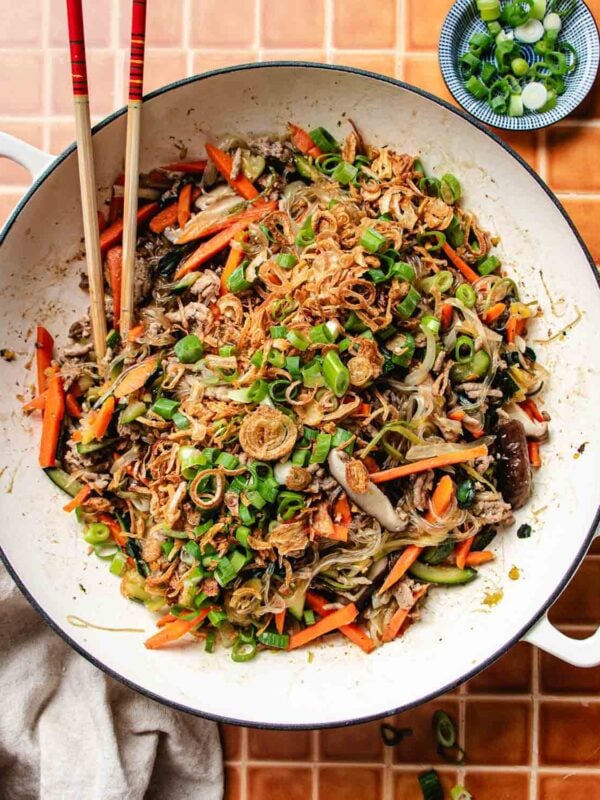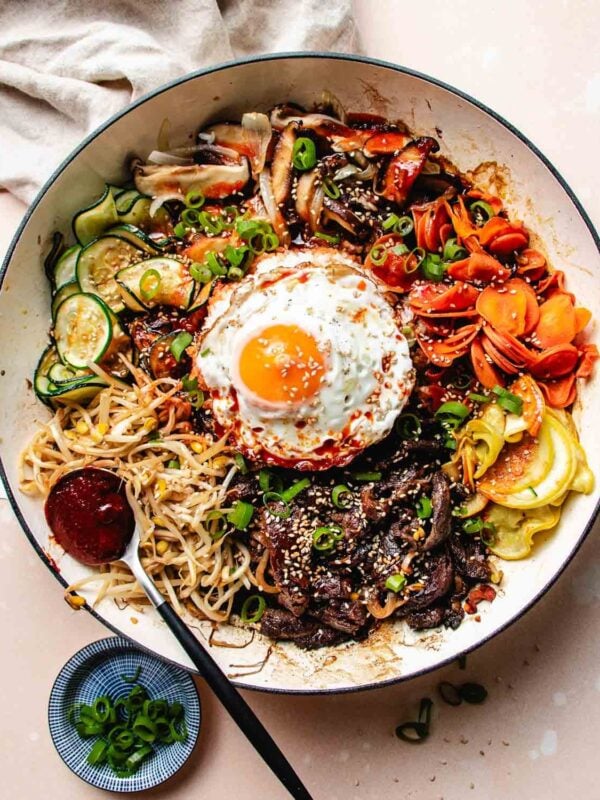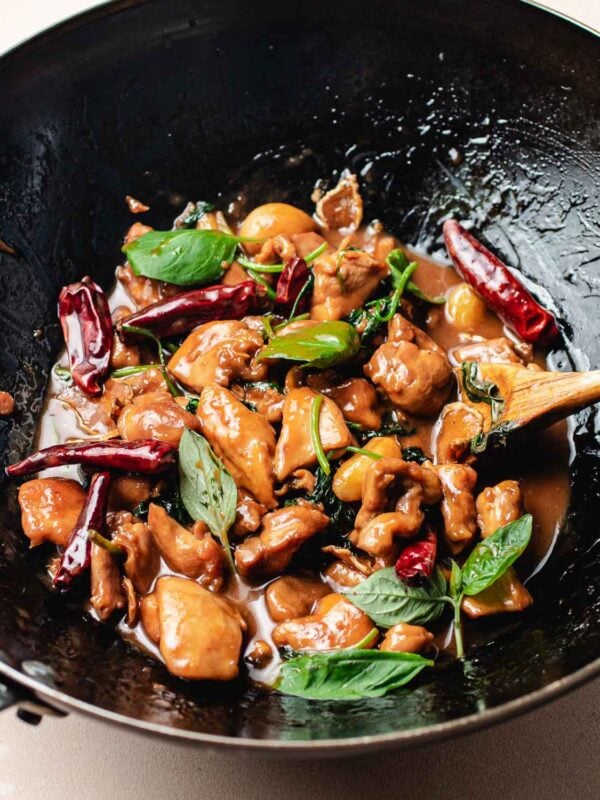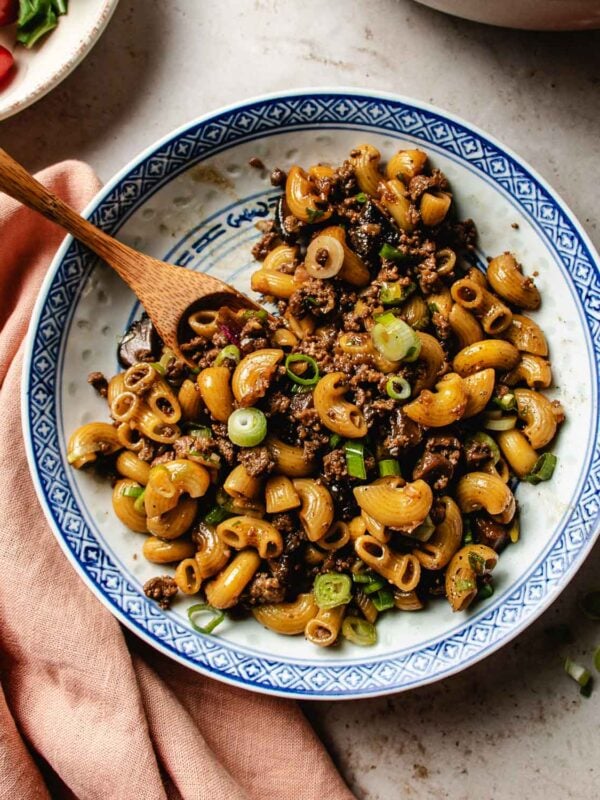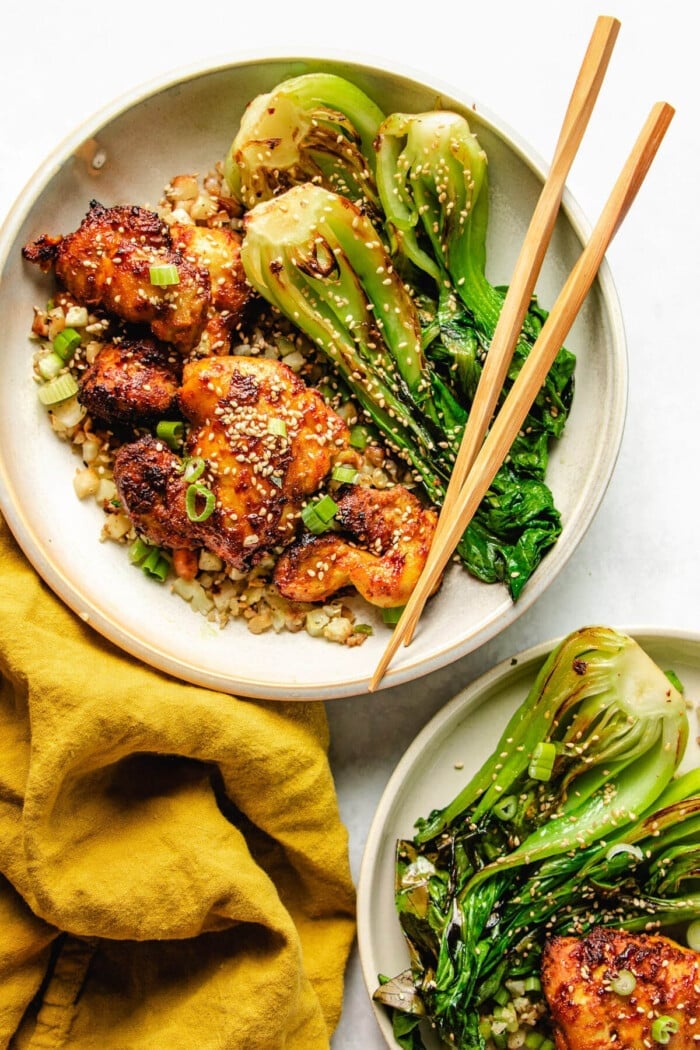This post may contain affiliate links. Please read our disclosure policy.
Baked trout with miso butter is one of the simplest, most flavorful fish recipes you can make. A quick spread of miso butter over the fillet keeps it tender and full of savory depth — all with just a handful of ingredients.
If you’re new to trout, it’s milder than salmon with a light, nutty-sweet flavor. Because it cooks quickly, the trick is not to overbake — this recipe shows you how to get it juicy and buttery tender every time.
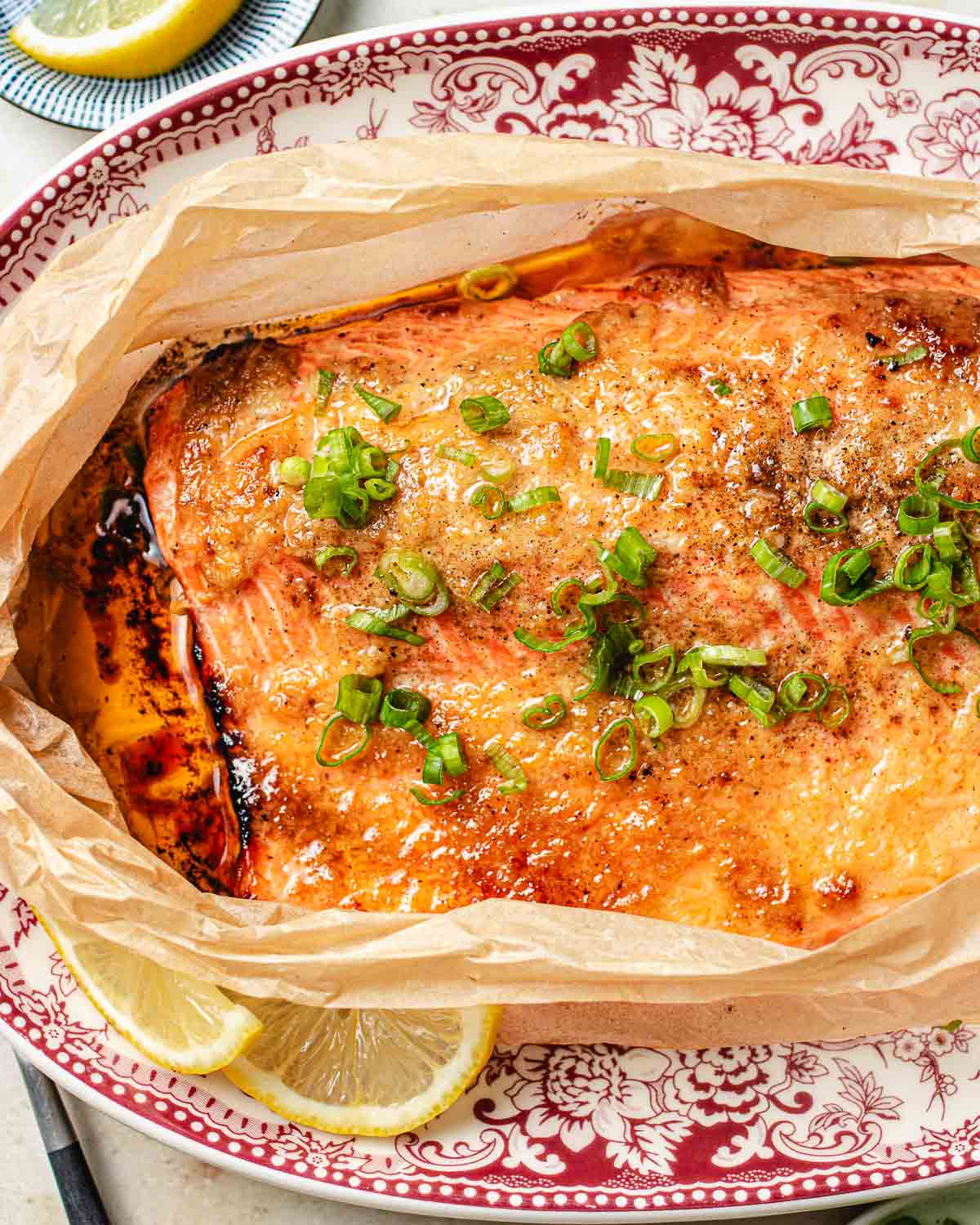
Why I love this dish

I’ve been seeing more fresh trout fillets at my local store lately, and after trying them, I was hooked. Trout is a little milder than salmon or char, with a nutty-sweet flavor that feels light and clean — a great entry point if you’re looking to try a new fish. It’s easy enough for weeknights yet special enough for friends or even a holiday table.
Key ingredient highlights
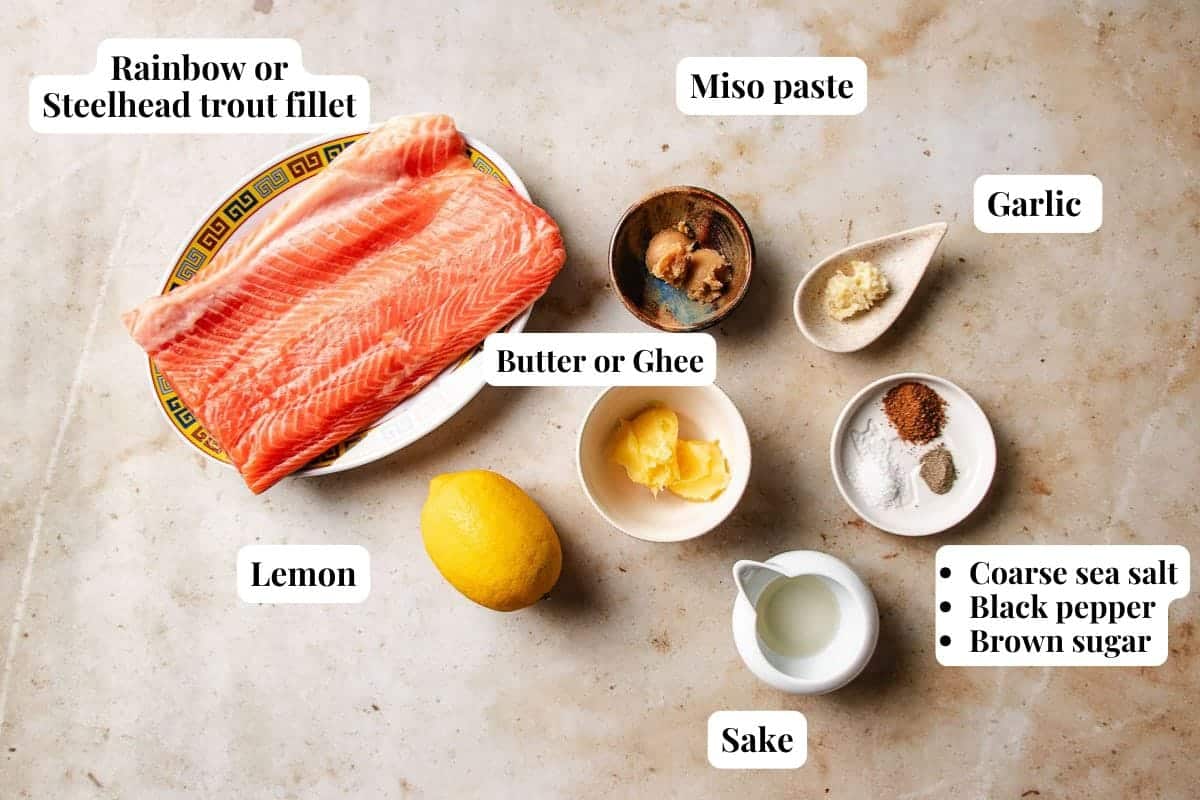
- Trout: You can use either rainbow or steelhead here — I give instructions for both. For this recipe, I used filleted steelhead trout, which is thicker (about 1 inch) with orange flesh and a bit more fat so it stays juicy. Rainbow trout is thinner, paler in color, and cooks quicker.
- Miso Butter: Just softened butter (or ghee) mashed with white or yellow miso and garlic. The miso brings umami and saltiness, and the butter adds richness while helping the trout bake up tender.
- Sake or Dry Sherry: Just a splash over the fish before baking. It helps take away any fishy edge and gives a light, aromatic note in the background.
- Brown Sugar: Only half a teaspoon, but it softens the sharpness of miso and rounds out the flavor with a subtle sweetness.
How to make baked trout with miso butter
This is one of the easiest fish recipes you can make. You mix a quick miso butter, spread it over the ruby red fillet, wrap, and bake. The miso butter not only adds flavor but also helps prevent the fish from drying out. See my recipe card below for the full step-by-step instructions — here are a few key things to know before you start:
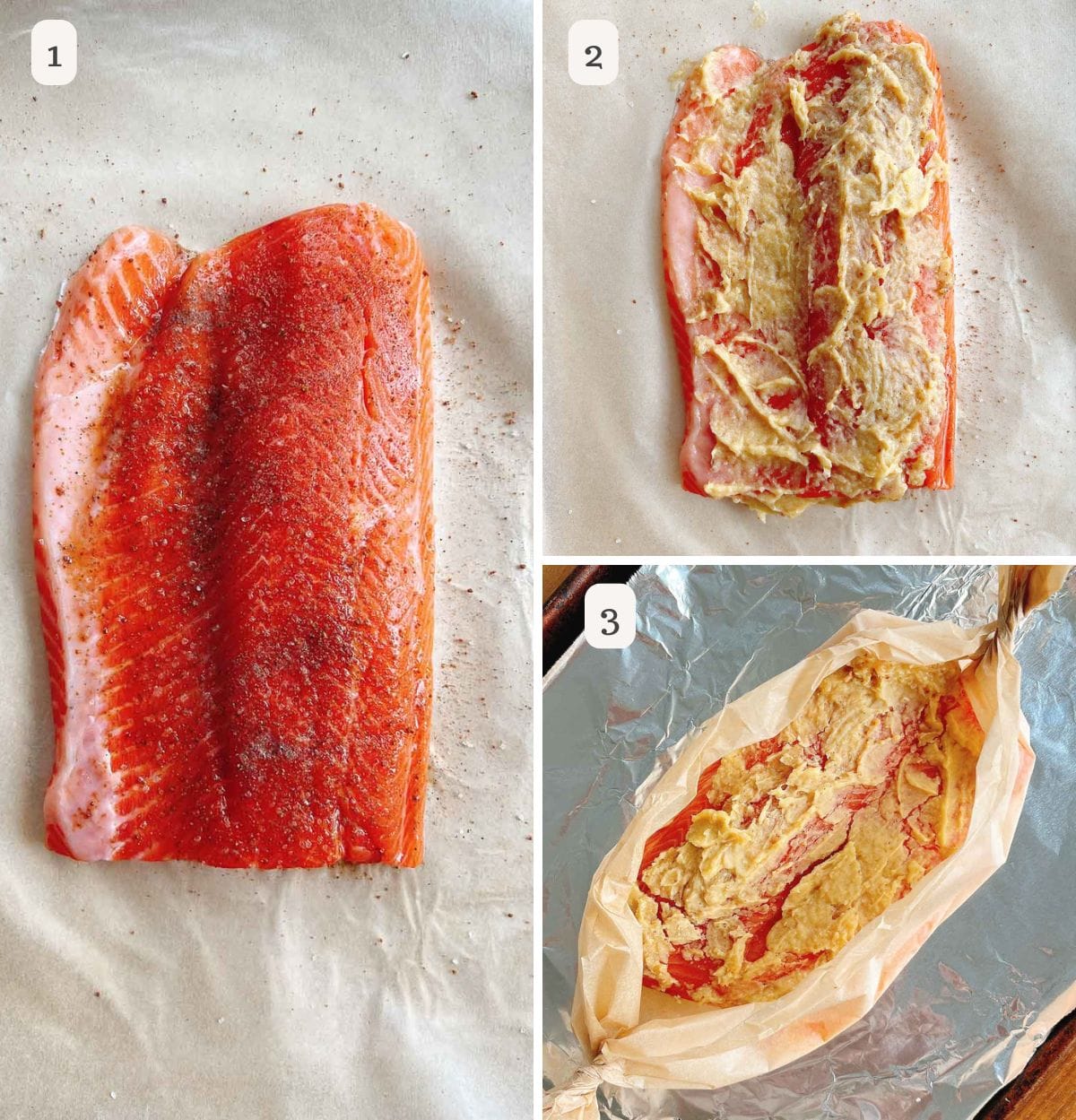
- Bake your fish in packets
Trout fillets aren’t all the same.- Steelhead (thicker, orange flesh, about 1 inch): Use the candy-wrap style. It creates a loose tent so the fish bakes gently without steaming too much.
- Rainbow (thinner, paler flesh): Use a sealed parchment pouch. This traps steam and keeps leaner fillets from drying out.
- Getting the wrapping right solves two of the most common issues — uneven cooking and soggy or dry fish.
- Watch the baking time (and doneness)
Trout cooks quickly, so start checking early. Steelhead fillets (thicker) usually take 14–16 minutes, while rainbow fillets (thinner) need only 12–14 minutes. At the thickest part, the fish should flake easily with a fork — that’s your best visual cue. For exact temperatures, see my recipe card below.- Tip: Carryover heat adds another 3–5°F after you pull it from the oven, so don’t wait until it looks “perfect” — it will finish as it rests.
- Don’t worry about the skin
The skin will be soft — that’s normal when baking in parchment. Just flake the fillet away and drizzle the buttery miso sauce over the top. - How much miso butter to use
Two tablespoons of miso butter is just right for a 1–1 ¼ lb fillet. If your fillet is smaller, use less. A good rule of thumb: spread a thin, even layer across the top of the fish. You don’t want it piled on too thick or the miso will overpower the red trout’s flavor.
What to serve with miso butter trout
This trout is light yet flavorful, so it pairs easily with vegetable sides and holiday dishes. Here are some ideas to round out the meal:
- Salads: A refreshing enoki mushroom salad or chopped kale salad brings brightness and crunch alongside the rich fish.
- Vegetable sauté: Keep it simple with sautéed napa cabbage or a classic bok choy stir fry — both are light greens that balance the buttery miso trout.
- Holiday table: For a seasonal spread, serve it with miso sweet potatoes, roasted red kuri squash, or roasted delicata squash. These cozy sides make the trout feel right at home on a festive table.
FAQs
Yes. Just thaw the fillet completely in the fridge overnight and pat it dry before baking. If the fish is still icy or wet, it won’t season well and can bake unevenly or turn soggy in the packet.
Store cooked trout in an airtight container in the fridge for 1–2 days. Fish is always best fresh, but this dish reheats nicely if eaten soon after.
I like to reheat it in the microwave on medium power for about 30 seconds, just until warmed through. This keeps the fish moist and avoids overcooking.
Try these trout recipes next!
If you enjoyed this baked version, here are a few more trout (and salmon) dishes to keep things exciting in your kitchen:
- Pan seared trout with ginger scallion sauce — a stovetop method that gives you crispy skin and a punchy, aromatic topping.
- Air fryer trout — quick, easy, and perfect for busy weeknights.
- Orange glazed salmon — similar to this dish, but made with a whole salmon fillet roasted and finished with a bright citrus glaze.
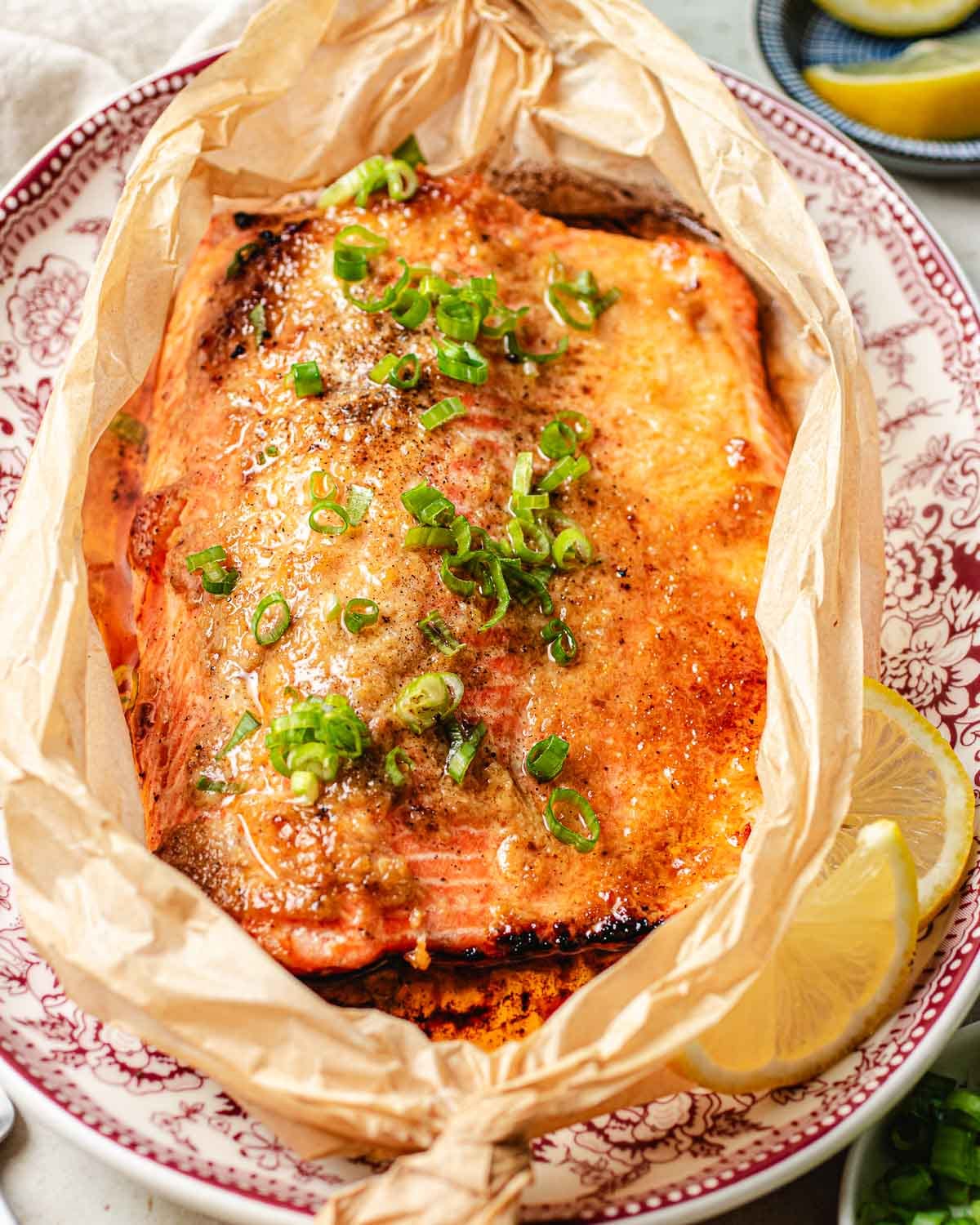
Baked trout with miso butter recipe
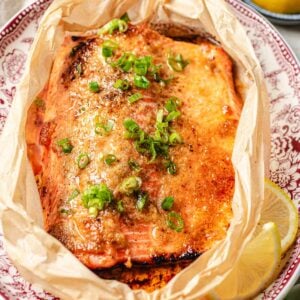
Ingredients
- 1-1.25 lb center-cut steelhead or rainbow trout fillet about 1 inch at the thickest part, orange flesh, skin on or off
- 2 tbsp ghee or butter softened to room temperature
- 2.5 tsp white or yellow miso paste
- 0.21 oz garlic cloves grated (2 small)
- ½ tbsp sake or dry sherry
- ¼ tsp coarse sea salt
- ⅛ tsp ground black pepper
- ½ tsp brown sugar
For garnish:
- Fresh lemon juice for serving, not baked in
- 1 scallion bulb diced into small rounds
Instructions
- Preheat oven: Preheat oven to 400°F (200°C). Cut a large sheet of parchment paper.
- Make miso butter: In a small bowl, mash together ghee (or softened butter), miso paste, and garlic until smooth.
- Season fish: Place trout fillet in the center. Pat dry and drizzle with sake, then sprinkle with salt, black pepper, and brown sugar. Spread the miso butter evenly over the top.
- Wrap according to thickness:
- – For thick steelhead/ rainbow trout (about 1 inch at the thickest part, ~1 lb or larger): Use a candy-wrap style. Bring the parchment up around the fish and twist the ends tightly like a wrapped sweet. This forms a loose tent over the fish, letting a little steam escape so the fillet bakes gently without over-steaming.
- – For thin white-flesh trout fillets (smaller, delicate, leaner): Use a fully sealed parchment pouch (classic en papillote). Fold the edges all the way around to trap steam inside. This keeps thinner, leaner fillets moist and prevents them from drying out.
- Bake: Place the wrapped fish on a baking sheet and bake for 14–16 minutes (steelhead/rainbow) or 12–14 minutes (thin fillet trout). Look for opaque flesh that flakes easily, with just a faint blush in the middle.
- Serve: Carefully open the parchment (watch the steam). Spoon any melted miso butter from the packet over the fish. The skin will be soft rather than crispy — simply flake the fillet away from the skin and enjoy it with the buttery sauce. Finish with lemon juice and scallions. Serve warm.
Notes
- Steelhead trout is richer and fattier, so the looser “candy-wrap” method works best. It keeps the texture juicy without over-steaming.
- Thinner, leaner trout (white-flesh) benefits from a fully sealed pouch, which locks in steam and keeps the fish moist.
- The skin will not turn crispy with this parchment style of baking. The upside is that the fish stays incredibly moist and juicy. For crispy skin, pan-seared trout is a better option (recipe coming soon).
- Cooking temperature guide (with carryover heat):
- 125°F (52°C) – Pull the trout when it hits this temp. Carryover heat will raise it a few degrees as it rests, bringing it closer to 130°F. This leaves the fish moist, tender, and slightly pale pink in the center (chef’s choice).
- 135–140°F (57–60°C) – After resting, the fish will be closer to 138–142°F. The flesh will be fully opaque, flaky, and still juicy.
- 145°F (63°C, FDA guideline) – If you bake all the way to this temp, carryover will push it higher. The fish will be completely cooked through but more likely to be on the dry side.
- Visual cues: The trout should look opaque on the outside and flake easily with a fork at the thickest part. A faint pale pink in the very center (like salmon) is safe to eat and gives the juiciest results.
Nutrition
Nutrition information is automatically calculated, so should only be used as an approximation.
Made a dish and loved it? Please rate the recipe and leave a comment in the section below! It helps my blog grow organically, allowing me to continue sharing free and awesome content with you. Thank you!
